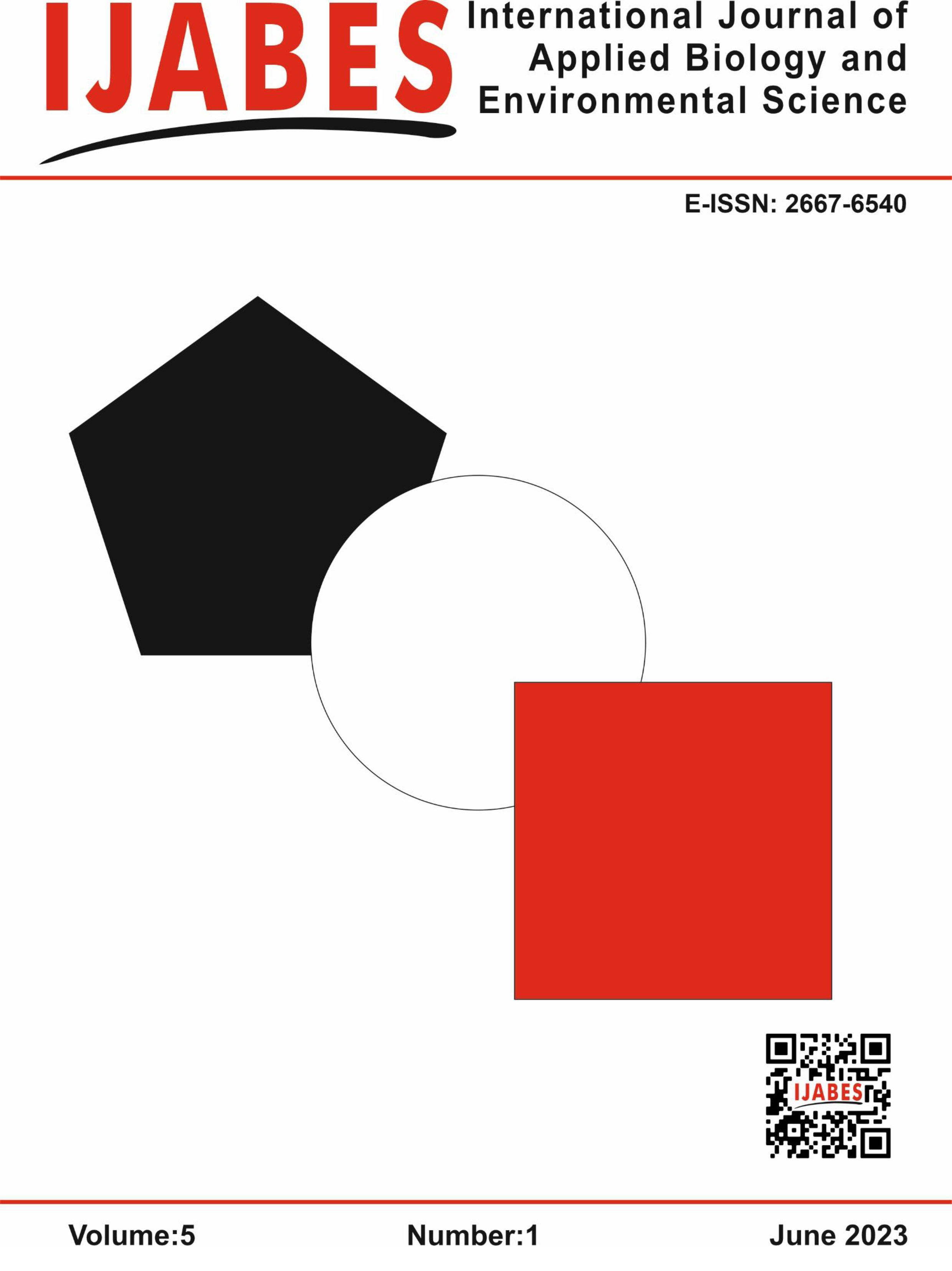








Yayımcı adresi: Hadımköy TOKİ Mevlana Cd. B1/2 D:2
Hadımköy / Arnavutköy / İstanbul

This work Licensed under the Creative Commons Attribution 4.0 International License.
Volume: 2 Issue: 2 - 2020
| 1. | Cover Page I |
| 2. | Contents Pages II - III |
| ORIGINAL RESEARCH | |
| 3. | Protectıve Effect Of Carvacrol Against Oxidative Stress Injury in Rats Following Renal Ischemia/Reperfusion Ozlem Gunduz, Mediha Canbek, Emre Ceyhan, Mustafa Uyanoglu, Hakan Senturk, Gokhan Bayramoglu, Güngör Kanbak, Kazım Kartkaya, Asegul Oglakci Ilhan, Ayse Ozmen Yaylaci doi: 10.5505/ijabes.2020.07108 Pages 1 - 6 Bu çalışmada ratlarda deneysel renal iskemi/reperfüzyon hasarına karşı karvakrolün olası koruyucu etkileri araştırıldı. Gruplar Grup I (kontrol), Grup II (I/R+ SF), Grup III (I/R+ Zeytin yağı), Grup IV (I/R+ zeytin yağı +25 mg/kg karvacrol) ve Grup V (I/R + Zeytin Yağı+ 50 mg/kg karvakrol) olarak belirlendi. Grup II, III ve IV'e sağ nefroktomiden sonra 45 dakika iskemi ve 24 saat reperfüzyon uygulandı. Elektroforez yntemi ile CAT, SOD, Gpx enzim aktiviteleri belirlendi. BUN, CRE, MDA, MPO seviyeleri spektrofotometrik yöntemle belirlendi. böbrek dokularında klasik HE boyama gerçekleştirildi. Kontrol ile karşılaştrıdığında SOD, CAT, Gpx aktiviteleri bütün gruplarda arttı. Grup II ile karşılaştırıldığında SOD, CAT, Gpx seviyeleri dereceli olarak azalır ve enzim aktivitesi Grup V'de en azdır. Grup 5 histopatolojik analizlerinde I/R hasarının önemli oranda azalmıştır. Bu sonuçlara göre renal iskemi/reperfüzyon hasarına karşı karvakrolün 50 mg/kg dozunun, 25 mg/kg dozuna göre daha etkili olduğu gözlenmiştir. In this study, possible protective effects of carvacrol were investigated against experimental renal ischemia/reperfusion (I/R) injury in rats. Groups are determined as Group I (Control), Group II (I/R+saline), Group III (I/R+olive oil), Group IV (I/R+olive oil+25 mg/kg carvacrol) and Group V (I/R+ olive oil +50 mg/kg carvacrol). After right nephrectomies 45 minutes of ischemia and 24 hours of reperfusion were applied to Group II, III, IV. SOD, CAT and Gpx activities were determined by electrophoresis. BUN, CRE MDA, MPO levels were determined spectrophotometrically. Classical HE staining of renal tissues was performed. Compared with control; SOD, CAT, Gpx activities were increased in all groups. Compared with Group II; SOD, CAT, Gpx activities were decreased gradually and enzyme activities is the lowest in Group V among all groups. Compared to Group IV with Group V; BUN, CRE, MDA, and MPO enzyme activity lowest than in Group V. In the Group V histopathological analyses, It was observed that the injury was significantly decreased. The results of this study have demonstrated that 50 mg/kg dose of carvacrol is more effective than 25 mg/kg dose of carvacrol against renal I/R injury prevention. |
| REVIEW ARTICLE | |
| 4. | Biologic preservation methods for used meats Dilek Keskin, Bülent Bozdogan doi: 10.5505/ijabes.2020.87597 Pages 7 - 13 Et ve et ürünlerinin mikrobiyal kontaminasyon oranının yüksek olmasından dolayı, tüketici sağlığını riske sokmayacak muhafaza yöntemlerine ihtiyaç duyulmaktadır.Etlerin bozulmasından sorumlu mikroorganizmalar olarak denince, küflerden Cladosporium, Sporotrichum, Geotrichum, Penicillium ve Mucor, mayalardan Candida spp., Cryptococcus spp. ve Rhodotorula spp., bakterilerden, Pseudomonas, Micrococcus, Streptococcus, Sarcina, Lactobacillus, Salmonella, Escherichia, Clostridium ve Bacillus türleri bilinmektedir. Bu mikroorganizmaları önlemek için farklı yöntemler kullanılmaktadır. Kullanılan yöntemler fiziksel, kimyasal ve biyolojik olmak üzere üç bölüme ayrılabilir. Kimyasal muhafaza yöntemleri yararlı olmakla birlikte, gıda ile birlikte alınan kimyasal kalıntılar nedeniyle risklidir. Etlerin muhafazasında antibiyotiklerin kullanımı sonucunda antibiyotiklere karşı direnç gelişebilmektedir. Bu nedenle doğal antimikrobiyal bileşikler kanatlı et ve et ürünlerinin muhafazasında tercih edilmektedir. Biyolojik muhafazada bitkilerden elde edilen esansiyel yağlar (saponinler, flavonoidler, karvakrol, timol, sitral öjenol, linalol, terpenler ve bunların öncülleri), hayvanlardan elde edilen lizozim, laktoferrin ve kitosan kullanılmaktadır. Mikroorganizmalardan ise bakteriyosinler (nisin, pediyosin, laktisinler, enterosinler ve diğerleri), bakteriofajlar ve endolizinler elde edilmektedir. Bu makalede, kanatlı etlerinde kullanılan biyolojik koruma yöntemleri özetlenmiş güncel yayınlardaki veriler derlenmiş ve söz konusu yöntemlerin kanatlı etlerinin korunmasında kullanım olanakları ile ilişkili yeni bulgular verilmiştir. Due to the high rate of microbial contamination of meat and meat products, there is a need for preservation methods that do not put consumer health at risk. In terms of microorganisms responsible for the deterioration of meat, molds include Cladosporium, Sporotrichum, Geotrichum, Penicillium and Mucor, Candida spp., Cryptococcus spp. and Rhodotorula spp., bacteria, Pseudomonas, Micrococcus, Streptococcus, Sarcina, Lactobacillus, Salmonella, Escherichia, Clostridium and Bacillus species are known. Different methods are used to prevent these microorganisms. The methods used can be divided into three parts: physical, chemical and biological. Chemical preservation methods are useful, but are risky due to chemical residues taken with food. The use of antibiotics in the preservation of meat may lead to resistance to antibiotics. Natural antimicrobial compounds are therefore preferred in the preservation of poultry meat and meat products. Essential oils (saponins, flavonoids, carvacrol, thymol, citral eugenol, linalol, terpenes and their precursors) obtained from plants in biological casing, lysozyme, lactoferrin and chitosan from animals are used. Bacteriocins (nisin, pediyosin, lacticins, enterosins and others), bacteriophages and endolysins are obtained from microorganisms. In this review, the latest knowledgeds are summarized the biological protection methods used in meats and new findings related to the possibilities of use of meat in the protection of meat are given. |
| 5. | Manisa (Turkey) Invertebrate Biodiversity Preliminary Study Tuğrul Öntürk doi: 10.5505/ijabes.2020.46220 Pages 14 - 34 As a result of literature researches conducted in Manisa province, 343 species of Invertebrates were identified. Eight of them are endemic species. Of these 8 species, 4 belong to Gastropoda, 3 belong to Coleoptera and 1 belong to Ephemeroptera. |